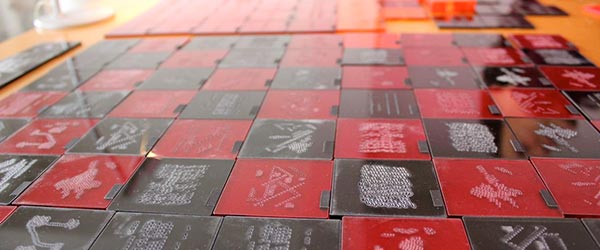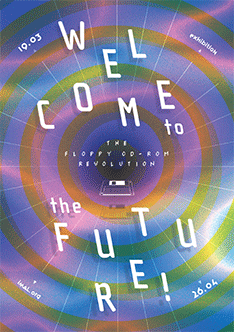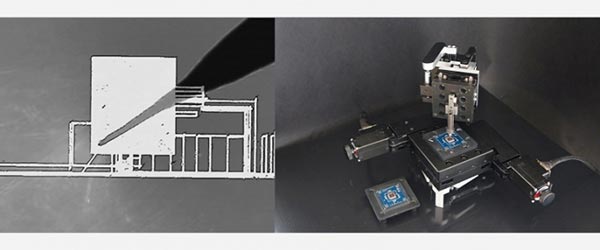In 2019, we start our Fablab Residency program! If you're an artist, designer, engineer or developer and want to develop a new creative project with our digital manufacturing machines, Fablab.iMAL can offer you a residency!
Interested? More here.

At once teacher at ENSAD, the Superior School of Decorative Arts in Paris, at Ensci and visiting professor in media design at HEAD (High School of Art and Design), Étienne Mineur, graphic designer with a passion for interactivity is also the co-founder and artistic director of the Incandescence design studio in 2000, known for its innovative websites. In 2009, he was co-founder and director of creation of "éditions volumiques", a research laboratory on books, paper and their relationship with technologiy (interactive books, augmented reality books, tangible/digital hybrid games).
What made you want to join the cd-rom industry?
I used to work on interactive kiosks and also on applications piloting laserdiscs... The transition to cd-rom felt very natural. In addition, the software we used (Director and HyperCard) was also compatible with the cd-rom medium, so the transition was quite logical (technically / design / usage...).
Did you consider the cd-rom as a new medium or as new media? Was there something like "cd-rom art"?
I think the cd-rom was just a period and that it was at that precise moment the vehicle of what we could call interactive art/interactive design. For example, the works of John Maeda (the Reactive Books) were first published on floppy disk, but after the advent of the cd-rom they were also available on that medium (more convenient, cheaper to produce, more robust...).
My work on interactive terminals (for Fnac, the Préfecture des Yvelines, museums,...) could have been either on cd-rom or on a hard drive. There was not much difference in terms of design and writing.
I think the cd-rom was just a period and that it was at that precise moment the vehicle of what we could call interactive art/interactive design.
What were the new opportunities offered by the cd-rom for content creators? Its characteristics? And for publishers?
It was primarily a distribution medium, with a large capacity (for that time), that was cheap to produce (using the same production lines as for audio CDs) and that took up very little space (usually thinner than a book). This was, after floppy disks, the first physical medium for mass distribution of digital content.
For publishers and distributors, it wasn't much different from the world of books. The classic process chain was maintained: producer / editor / author / diffuser / distributor... unlike the current publishing of dematerialised media that challenges the whole distribution chain.
For content creators (who came mainly from book publishing), it was a great opportunity to explore sound, animation, and a whole new form of writing (graphics, text, sound and above all interactivity).
Was the cd-rom a real "revolution" or just a way to aggregate previous existing forms?
For me it was primarily the transition of a language that had already been developed for interactive kiosks and the first video games on floppy disks. The big difference was that it actually had a very large storage capacity for that time (hence the cd-roms on museum collections, with a large number of pictures to discover).
For the general public, it was above all the ability to see images in "high definition" and in color on the screen. The French people were already familiar with interactivity thanks to the Minitel (French videotex service similar to Ceefax, ed), but in my opinion it was the possibility of adding sound, animation, text and picture at the same time that really made a drastic change.
One should also note that video games were already very advanced technically at the time and offered "interactive multimedia" as well but with a very different content.
What was the cd-rom that made you want to get started? Which one impressed you the most? Which was the most innovative?
I already worked with Index+ in the field of interactive design before the cd-rom became available, so we took it up quite early and without much previous reference. After that I was rather impressed by "Myst", a cd-rom game, not because of its gameplay but because of the quantity of images of great quality that we could discover all through this adventure. The most accomplished cd-rom, the most beautiful, the most intelligent... it was without hesitation: "L'alphabet" de Murielle Lefèvre, Frédéric Durieu and Jean-Jacques Birgé based on the book of Kvĕta Pacovská.
There were also American cd-roms like "The Complete Maus," Laurie Anderson's "Puppet Motel" and "The Society of Mind" with Marvin Minsky.
What were the main challenges to distribute and popularise this new publishing medium?
The number of people with a computer AND a cd-rom drive was very limited (and most of them were PC gamers who owned beefed up computers in order to play cd-rom games). The price was also important. I found myself for example in the digital section at the Fnac store where the video game Doom and the cd-rom of the Musée d'Orsay were sitting side by side at the same price (one can imagine that people owning a computer at the time would rather buy a game for the same money). In short, the population interested in museum collections and possessing a machine that could read these cd-roms at home was extremely limited.
How do you analyze the failure of the medium a posteriori?
A large majority of "authors" were people coming from the book world and not from the audiovisual media. Also, thinking in terms of pictures and animations was not so simple at the time. All disciplines (sound designer, graphic designer, animator, developer, editor ...) had to comply with technical constraints that were unheard of and very hard to master. So in the beginning we just transposed them from paper to screen (using the same codes...) and gradually we took our distances from the codes of paper (the famous turning pages).
The contents were essentially textual (at least for the French cultural cd-roms) and did not leave enough room to images and sound. Later, we put in more work into images and sound in order to develop a truly audiovisual experience. Personally, my typographical inspiration came more from film credits and TV graphics package (Canal+ from Etienne Robial for example) than from the classic typography of posters and books. Moreover, in "L'Alphabet" that I think is the most beautiful example of cd-rom, there is no text, only animated letters. No longer reading text on the screen was (is) not obvious.
Their heirs are the webdocs where we can find more or less the same language and types of representation, as well as the narrative dynamics.
What lessons can we draw for economic or practical models in current digital publications?
The cd-rom has actually appeared at the same time as the Web (early 90s) and the first games in real time 3D ("Doom" dates from 1993). In my opinion it was overshadowed by those very fast and impressive games on one side and on the other by the incredible interactivity that we could find on the first websites (although the web only developed around 1996-1997 in France). Unlike cd-roms sold and distributed like books, the arrival of the Web and of free content radically changed the scene. Major publishers panicked and blocked many projects. So for almost 10 years they kept out of the digital (I am generalising here, oversimplifying). The arrival of the smartphone turned everything around again (distribution, usage, price...) but we're gradually going back to a paid model (subscriptions, low price apps...) that should help them recover their bearings.
In addition, "interactive" writing is now widespread (web, video games, social network...) and authors are much more likely to develop specific content for these new platforms. Still, the cultural cd-rom was a great period when we experienced with many things with exciting content. It was a school of interactivity for many people who later migrated towards games, the Web, edutainment...
What is the legacy of these cd-rom-experiments for contemporary creation and digital publishing? What are its descendants in the publishing industry?
The Web arrived quickly. I personally discovered the Internet and especially the Web in 1992-1993 and I began to migrate towards this new medium, even if the technical constraints were much higher (no more large images, animations...). It was a big regression for graphic possibilities. But the fundamentals of usage, of interactive design were there and we were able to adapt our findings from the cd-rom to the Web (although the first years were rather difficult).
Their heirs are the webdocs where we can find more or less the same language and types of representation, as well as the narrative dynamics. Or the Japanese visual novels for example.
Do you think that we should preserve these contents? If so, in what capacity and in what form?
My cd-rom archives have already started to deteriorate and several of my cd-roms have become unreadable (and my original files are mostly inaccessible because they are stored on magneto-optical media). We should be able to transfer everything on hard drives and use emulators to run them.
Interview by Marie Lechner, journalist specialised in digital cultures, and researcher at Pamal (Preservation-Archeology-Media art Lab) at the École Supérieure d'Art in Avignon (pamal.org)

A historical selection of art & culture cd-roms and electronic artworks published on floppies, mostly produced in the 90s highlighting the short life of born-digital art. It presents early pioneering works in new media and digital arts, conveying many visions and utopias around the upcoming digital world as well as remarkable explorations of interactive digital media.
WELCOME TO THE FUTURE
- Visions, Utopias & Politics
- New Art Forms
- Documenting Contemporary Art
- Digital Heritage
- All interviews
In 2019, we start our Fablab Residency program! If you're an artist, designer, engineer or developer and want to develop a new creative project with our digital manufacturing machines, Fablab.iMAL can offer you a residency!
Interested? More here.

In the context of Transmediale festival in Berlin, Wallonia Brussels International organises an exhibition showing pieces by 3 Brussels-based artists: Felix Luque, Julien Maire and LAb[au].
iMAL is very happy to be associated with this event as the co-producers of Julien's new work Composite as well as Felix's installations D.W.I. and Memory Lane.

Signals:...
The time has finally come: our renovation works at 30 Quai des Charbonnages started last week! After some demolition works, we can start building up our new, 3-storey centre for thedigital art and culture, which will open autumn 2019. Follow us on instagram,...
This page is an archive of the iMAL website that operated between 2010 and 2019. It compiles activities and projects made since 1999.
For our most recent news and activities, please check our new website at https://imal.org
asbl iMAL vzw - 30 Quai des Charbonnages Koolmijnenkaai 30 - 1080 Bruxelles Brussel 1080 - 32 (0)2 410 30 93
